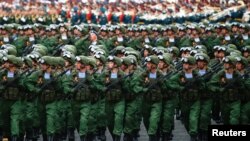On May 24, during the weekly “Government Hour” at the Federation Council, Russian Defense Minister Sergei Shoigu claimed that the country’s military had achieved “strategic parity” with NATO while spending eleven times less per serviceman than the United States.
According to TASS, Shoigu said that the United States spent $510,000 per serviceman each year, while Russia expended only $54,000.
“With this level of funding we succeeded last year in not only increasing our Armed forces’ combat capability by 14 percent, but also ensuring strategic parity with the countries of NATO.”
There are two components to this claim that need evaluating. The first is that the United States spends $510,000 per soldier each year. According to the U.S. Department of Defense, the enacted budget for the entire department in 2016 was $580.3 billion, while the total number of active military personnel (excluding reserves and civilian staff) was 1,301,300. Dividing the total budget by this number gives a figure of approximately $445,900 per active serviceman.
Dividing the 2016 military budget by Shoigu’s figure of $510,000 gives us roughly 1,137,800 - significantly fewer active personnel than listed by the DoD. But this number is strikingly similar to that which appears on the Wikipedia page for the United States Armed Forces, which, as of May 30, 2017, gives a total number of enlisted U.S. military personnel of 1,137,916. The source links for the figure given on Wikipedia are broken, but appear to cite figures from either 2010 or 2013. However, further confusing matters is the fact that if one takes the total number of “enlisted” servicemen for 2016 from the U.S. Defense Manpower Data Center (DMDC), which is 1,060,084, one gets an even higher cost per individual of over $547,000.
Shoigu’s figures may be inexact but they are not dramatically misleading, however it has been noted, of course, that dividing the total defense budget of a nation by the number of serving military personnel does not give much hint as to the actual cost of maintaining an individual soldier for a year.
Russia’s own figures are equally complicated, with a 2016 defense budget of approximately $65.4 billion while the Russian government claimed to have a total number of active soldiers of around one million. This would, by the same logic applied to U.S. spending, give a rough figure of around $65,400 per serviceman.
Once again Shoigu’s exact numbers are hard to verify, but the dramatic difference in spending relative to troop numbers is genuine. It should be noted though, that Russia, unlike the United States, not only has conscription to rely upon for cheap troops (though the relative number of professional soldiers is increasing), but also has a largely state-owned and directed military industrial complex.
When it comes to military parity between Russia and NATO as a whole however, the claim appears on shakier ground. After all, Russia lags far behind the United States in certain areas of military technology, most notably stealth, and possesses only one aircraft carrier, which has proven of little military worth, to NATO’s total of 22, with more due to come into service in the next few years. So Russia lags far behind NATO in long-distance power projection.
But Russia does have some specific advantages, such as a formidable arsenal of surface-to-air missile systems, long range artillery, and electronic warfare capabilities. Furthermore, Russia’s ability to project power quickly in Eastern Europe dramatically exceeds that of NATO.
Douglas Barrie, Senior Fellow at the International Institute for Strategic Studies, offered this assessment to Polygraph.info:
"I think Shoigu's comments regarding "strategic parity" and his broader claims as to the effectiveness of Russia defense spending were intended for a number of audiences, internal and external. In the strategic - or nuclear - realm Russia has been replacing older Soviet era systems with new missiles with new land, air and sea-based weaponry all entering the inventory. At the same time Russia has also been investing in more capable conventional systems with the purchase of upgraded versions of existing systems or new designs. The latest defense spending and weapons procurement plan is expected to be released in the third quarter of this year and has already been trailed as being less ambitious than the previous period, with some more expensive programs expected to be trimmed or delayed.As such Shoigu's comments can be taken as suggesting that less ambitious defense spending is not a concern given there is "strategic parity" and that Russian conventional defense spending is that much more "effective."In the case of the former parity is a vague notion, and in the case of the latter "effectiveness" is somewhat debatable, but there is no doubt that over the past decade the Russian military has benefited from increased investment. This, however, is investment on a Russian and not a Soviet scale."
But Justin Bronk, a research fellow at the Royal United Services Institute, cautioned that Russian military capabilities were still far behind those of NATO in most non-nuclear areas:
“In spite of relatively successful reforms since 2008, it is still absurd to claim that the Russian military has reached parity with NATO as a whole in conventional terms. The only area where Russia is not at a huge strategic disadvantage vis a vis NATO as a whole is in nuclear weapons. However, what is true is that in a short conflict near Russia's borders, Russia could quickly mass forces sufficient to overwhelm local NATO troops and it would take time for NATO to build up sufficient reserve forces to dislodge them.”
Russia’s military is capable of fulfilling short term goals such as moving rapidly into neighboring countries and could, in such circumstances, match NATO forces on the ground, while its nuclear arsenal ensures continued strategic security. This doesn’t mean that Russia has really achieved “parity” with NATO, but Shoigu is not wrong about the dramatic difference in investment relative to immediate capabilities.
